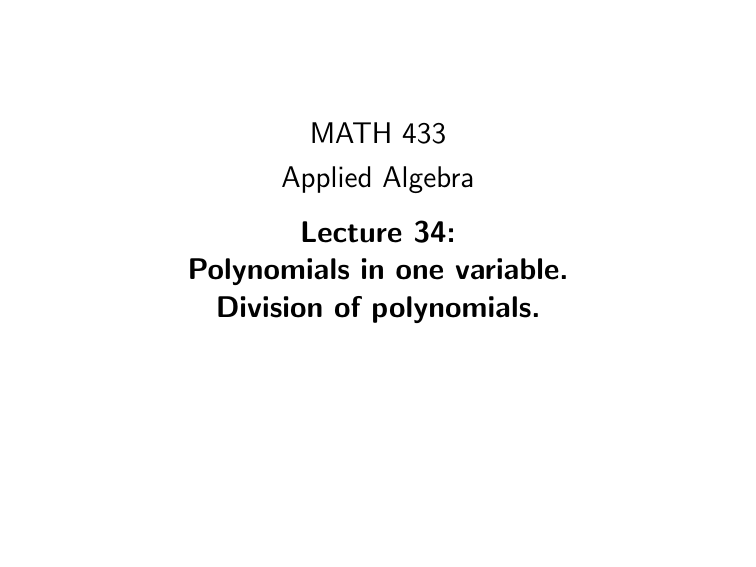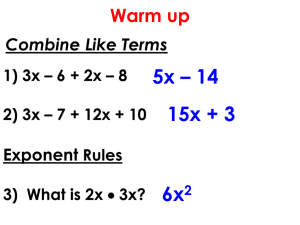MATH 433 Applied Algebra Lecture 34: Polynomials in one variable.
advertisement

MATH 433
Applied Algebra
Lecture 34:
Polynomials in one variable.
Division of polynomials.
Polynomials in one variable
Definition. A polynomial in a variable X over a ring R is an
expression of the form
p(X ) = c0 X 0 + c1 X 1 + c2 X 2 + · · · + cn X n ,
where c0 , c1 , . . . , cn are elements of the ring R (called
coefficients of the polynomial). The degree deg(p) of the
polynomial p(X ) is the largest integer k such that ck 6= 0.
The set of all such polynomials is denoted R[X ].
Remarks on notation. The polynomial is denoted p(X ) or p.
The terms c0 X 0 and c1 X 1 are usually written as c0 and c1 X .
Zero terms 0X k are usually omitted. Also, the terms may be
rearranged, e.g., p(X ) = cn X n + cn−1 X n−1 + · · · + c1 X + c0 .
This does not change the polynomial.
Remark on formalism. Formally, a polynomial p(X ) is
determined by an infinite sequence (c0 , c1 , c2 , . . . ) of elements
of R such that ck = 0 for k large enough.
Arithmetic of polynomials
From now on, we consider polynomials over a field F.
If
p(X ) = a0 + a1 X + a2 X 2 + · · · + an X n ,
q(X ) = b0 + b1 X + b2 X 2 + · · · + bm X m ,
then (p+q)(X ) = (a0 +b0 ) + (a1 +b1 )X + · · · + (ad +bd )X d ,
where d = max(n, m) and missing coeficients are assumed to
be zeroes. Also, (λp)(X ) = (λa0 ) + (λa1 )X + · · · + (λan )X n
for all λ ∈ F. This makes F[X ] into a vector space over F,
with a basis X 0 , X 1 , X 2 , . . . , X n , . . .
Further, (pq)(X ) = c0 + c1 X + c2 X 2 + · · · + cn+m X n+m ,
where ck = a0 bk + a1 bk−1 + · · · + ak−1 b1 + ak b0 .
Equivalently, the product pq is a bilinear function defined on
elements of the basis by X n X m = X n+m for all n, m ≥ 0.
Now F[X ] is a commutative ring and an associative F-algebra.
Notice that deg(p ± q) ≤ max(deg(p), deg(q)). If p, q 6= 0
then deg(pq) = deg(p) + deg(q).
Polynomial expression vs. polynomial function
By definition, a polynomial
p(X ) = cn X n + cn−1 X n−1 + · · · + c1 X + c0 ∈ F[X ] is just an
expression. However we can evaluate it at any α ∈ F to
p(α) = cn αn + cn−1 αn−1 + · · · + c1 α + c0 , which is an element
of F. Hence each polynomial p(X ) ∈ F[X ] gives rise to a
polynomial function p : F → F. One can check that
(p + q)(α) = p(α) + q(α) and (pq)(α) = p(α)q(α) for all
p(X ), q(X ) ∈ F[X ] and α ∈ F.
Theorem All polynomials in F[X ] are uniquely determined
by the induced polynomial functions if and only if F is infinite.
Proof: Suppose F is finite, F = {α1 , α2 , . . . , αk }. Then a
polynomial p(X ) = (X − α1 )(X − α2 ) . . . (X − αk ) gives rise
to the same function as the zero polynomial.
If F is infinite, then any polynomial of degree at most n is
uniquely determined by its values at n + 1 distinct points of F.
Division of polynomials
Let p(X ) and s(X ) be polynomials and s(X ) 6= 0. We say
that s(X ) divides p(X ) if p = qs for some polynomial q(X ).
Then q is called the quotient of p by s.
Let p(X ) and s(X ) be polynomials and s(X ) be of positive
degree. Suppose that p = qs + r for some polynomials q and
r such that the degree of r is less than the degree of s. Then
r is the remainder and q is the (partial) quotient of p by s.
Note that s(X ) divides p(X ) if the remainder is 0.
Theorem Let p(X ) and s(X ) be polynomials and s(X ) be of
positive degree. Then the remainder and the quotient of p by
s are well-defined. Moreover, they are unique.
Long division of polynomials
Problem. Divide x 4 + 2x 3 − 3x 2 − 9x − 7 by x 2 − 2x − 3.
x 2 + 4x
2
4
+
8
3
x − 2x − 3 | x + 2x − 3x 2 − 9x − 7
x 4 − 2x 3 − 3x 2
4x 3
− 9x − 7
4x 3 − 8x 2 − 12x
8x 2 + 3x − 7
8x 2 − 16x − 24
19x + 17
We have obtained that
x 4 + 2x 3 − 3x 2 − 9x − 7 = x 2 (x 2 − 2x − 3) + 4x 3 − 9x − 7,
4x 3 − 9x − 7 = 4x(x 2 − 2x − 3) + 8x 2 + 3x − 7,
8x 2 + 3x − 7 = 8(x 2 − 2x − 3) + 19x + 17. Therefore
x 4 + 2x 3 −3x 2 −9x −7 = (x 2 + 4x + 8)(x 2 −2x −3) + 19x + 17.







